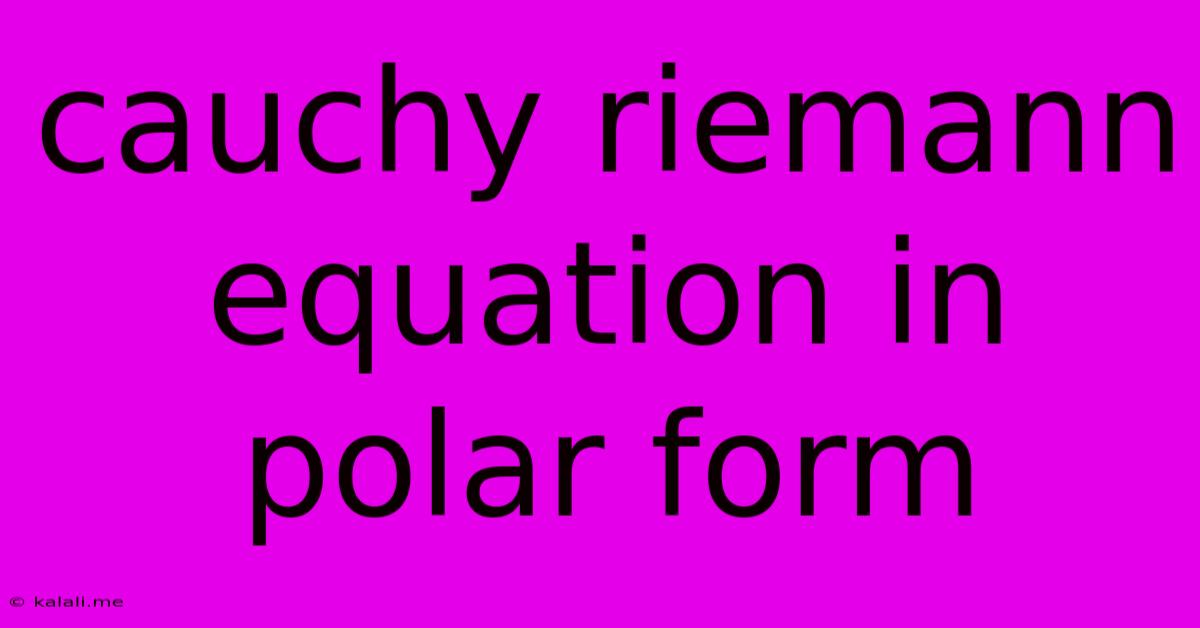Cauchy Riemann Equation In Polar Form
Kalali
Jun 16, 2025 · 3 min read

Table of Contents
Cauchy-Riemann Equations in Polar Form: A Comprehensive Guide
The Cauchy-Riemann equations are fundamental in complex analysis, providing a necessary condition for a complex function to be differentiable. While commonly expressed in Cartesian coordinates, their polar form offers unique advantages when dealing with functions exhibiting radial symmetry or expressed more naturally in polar terms. This article delves into the derivation and applications of the Cauchy-Riemann equations in polar form. Understanding these equations is crucial for mastering concepts like analyticity and conformal mapping in complex analysis.
Understanding the Cartesian Form
Before diving into the polar form, let's briefly review the Cauchy-Riemann equations in their familiar Cartesian form. For a complex function f(z) = u(x, y) + iv(x, y), where z = x + iy, the Cauchy-Riemann equations are:
- ∂u/∂x = ∂v/∂y
- ∂u/∂y = -∂v/∂x
These equations state that the partial derivatives of the real and imaginary parts of the function must satisfy specific relationships for the function to be complex differentiable (analytic) at a point.
Deriving the Polar Form
To express the Cauchy-Riemann equations in polar coordinates, we use the transformation:
- x = r cos θ
- y = r sin θ
And we define f(z) = u(r, θ) + iv(r, θ). Applying the chain rule to the Cartesian equations, we get the polar form:
- ∂u/∂r = (1/r) ∂v/∂θ
- ∂v/∂r = -(1/r) ∂u/∂θ
This derivation involves careful application of the chain rule to the partial derivatives with respect to x and y, expressing them in terms of r and θ. The factor of 1/r arises from the Jacobian of the transformation from Cartesian to polar coordinates.
Significance and Applications
The polar form of the Cauchy-Riemann equations proves particularly useful in several scenarios:
-
Functions with Radial Symmetry: Many problems in physics and engineering involve functions with radial symmetry, making the polar form a more natural and efficient representation. For example, analyzing electric fields around a charged wire or fluid flow patterns.
-
Conformal Mapping: Understanding conformal mapping, the transformation of regions in the complex plane that preserves angles, becomes simpler when using the polar form, particularly when mapping regions with circular boundaries.
-
Solving Laplace's Equation: The Cauchy-Riemann equations are deeply connected to Laplace's equation, which describes many physical phenomena. The polar form helps in solving Laplace's equation in polar coordinates, leading to simpler solutions for problems with radial symmetry.
Example: Analyzing a Function in Polar Coordinates
Let's consider the function f(z) = z². In Cartesian coordinates, f(z) = (x² - y²) + i(2xy). In polar coordinates, f(z) = r²(cos(2θ) + i sin(2θ)). Therefore:
- u(r, θ) = r²cos(2θ)
- v(r, θ) = r²sin(2θ)
Applying the polar form of the Cauchy-Riemann equations:
- ∂u/∂r = 2rcos(2θ) and (1/r)∂v/∂θ = 2rcos(2θ)
- ∂v/∂r = 2rsin(2θ) and -(1/r)∂u/∂θ = 2rsin(2θ)
The equations hold, confirming the analyticity of f(z) = z².
Conclusion
The Cauchy-Riemann equations in polar form offer a powerful tool for analyzing complex functions, especially those with radial symmetry or naturally expressed in polar coordinates. Mastering this form expands the applicability of complex analysis to a wider range of problems in various fields. Understanding both the Cartesian and polar forms provides a comprehensive grasp of this fundamental concept in complex analysis.
Latest Posts
Latest Posts
-
How To Create Clickable Image In Html
Jun 16, 2025
-
What Are The Factors Of 121
Jun 16, 2025
-
What Is A Theme Of The Passage
Jun 16, 2025
-
A Company That Provides Access To The Internet
Jun 16, 2025
-
Which Word Is Closest In Meaning To The Underlined Word
Jun 16, 2025
Related Post
Thank you for visiting our website which covers about Cauchy Riemann Equation In Polar Form . We hope the information provided has been useful to you. Feel free to contact us if you have any questions or need further assistance. See you next time and don't miss to bookmark.